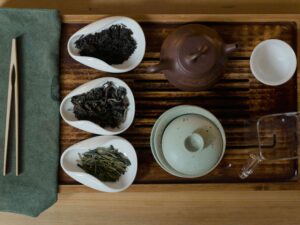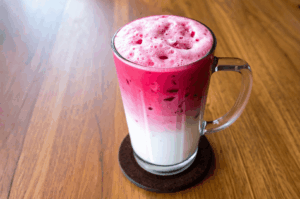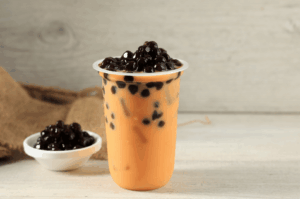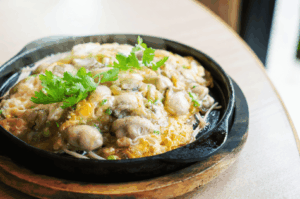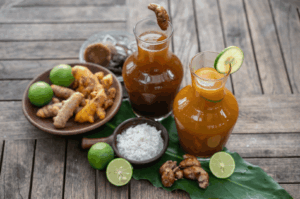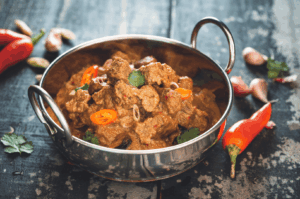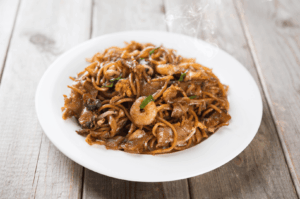
The dawn breaks over Hanoi, and the city awakens not to alarm clocks but to the clatter of tiny spoons and the metallic click of filters. The air fills with the dark, roasted aroma of authentic Vietnamese coffee drifting from bustling corners and sidewalk stalls. They are not rushing. Instead, they are waiting—waiting for the slow magic of the phin filter, such a simple device yet capable of producing a drink layered with history, flavor, and memory that only coffee makes possible. Across Vietnam, a remarkable variety of coffees awaits, from the rich and creamy egg coffee to refreshing coconut coffee and other unique local preparations, each offering a distinct taste of Vietnamese coffee culture.
In front of each customer rests a glass lined with a thick, creamy base of sweetened condensed milk. Above it, the filter begins its slow drip, releasing a stream of bold, freshly brewed cup after cup of coffee made from Vietnamese ground coffee. Once the brewing process is complete, the glass is stirred, then poured over ice cubes into a tall glass. This is Ca Phe Sua Da—the iconic Vietnamese iced coffee recipe that has become both a daily staple and a cultural treasure.
Introduction to Vietnamese Coffee Culture

Travelers are encouraged to try different Vietnamese coffees to fully experience the local café culture and explore the unique flavors each variety offers.
At the heart of this culture is the beloved Vietnamese iced coffee, or cafe sua da. This iconic drink, made by combining robust Vietnamese coffee beans with condensed milk and ice, is a staple in coffee shops across the country. Whether enjoyed in a Vietnamese coffee shop with friends or sipped solo as a midday pick-me-up, cafe sua da embodies the spirit of connection and relaxation.

Though Vietnam is now one of the largest coffee producers in the world, coffee was not native to its soil. It was the French who first introduced coffee grounds to Vietnam in the 19th century. Arabica trees struggled in the tropical climate, but robusta beans, with their resilience, high caffeine content, and deep bitter profile, thrived in the Central Highlands. Over time, Vietnamese coffee beans became prized for their strength and became the backbone of what we now know as traditional Vietnamese iced coffee.
What Makes Vietnamese Coffee Unique?
Unlike black coffee brewed in large drip machines or fast espresso shots, Vietnamese coffee is defined by its slow drip method. Using a Vietnamese coffee filter or phin, boiling water is poured over espresso roast ground or premium blend beans, and the liquid is allowed to brew at its own pace. Some enthusiasts even use only half the water to intensify the flavor, creating a rich coffee with a boldness that lingers on the palate.
This unique approach creates the authentic taste that keeps locals and tourists returning for more.
Vietnamese Coffee Ingredients and Equipment
Crafting an authentic Vietnamese coffee begins with selecting the right ingredients and tools:
- Vietnamese ground coffee: Brands like Trung Nguyen brand, Trung Nguyen Gourmet Blend, and even Cafe Du Monde are beloved for their bold, aromatic profiles.
- Sweetened condensed milk: Many locals recommend Longevity Brand for the perfect balance of sweetness.
- Phin filter: This small metal filter is such a simple device, yet it extracts maximum flavor.
- Hot water and coffee filters: Essential for releasing deep, robust notes.
- Tall glass filled with ice cubes: To transform strong hot coffee into a refreshing iced coffee recipe.
Together, these ingredients create good coffee that balances bitterness with rich sweetness.
The Art of Preparation: From Grounds to Glass
To make Vietnamese iced coffee at home is to practice patience. The steps are simple, yet ritualistic:
- Place 2 tablespoons of Vietnamese ground coffee—whether Trung Nguyen Gourmet Blend, Trung Nguyen brand, or the Cafe Du Monde chicory mix—into the phin filter.
- Tamp lightly with the cup spanner (the press).
- At the bottom of your glass, add sweetened condensed milk—about 2–3 tablespoons.
- Pour a splash of hot water to bloom the grounds.
- Fill with boiling water, cover, and allow the coffee drip to unfold over 4–5 minutes.
- Stir into a sweet coffee with rich sweetness.
- Pour into a glass filled with ice cubes.
This process yields the same great strong flavor whether at home or while visiting Vietnam.
Traditional Vietnamese Coffee Recipes
At the heart of Vietnam’s coffee culture lies the beloved ritual of crafting traditional Vietnamese iced coffee, or cafe sua da. This classic drink is celebrated for its bold simplicity and unforgettable flavor. The process begins with high-quality Vietnamese ground coffee—often from renowned brands like Trung Nguyen or Cafe Du Monde—which is carefully measured into a phin filter. As hot water is poured over the grounds, the coffee slowly drips, extracting a deep, aromatic brew that captures the essence of Vietnamese coffee.
Once the coffee is ready, it’s poured over a generous layer of sweetened condensed milk at the bottom of a glass. The two are stirred together, creating a harmonious blend of strong, robust coffee and creamy, sweet richness. Finally, the mixture is poured over ice, transforming it into the refreshing and invigorating Vietnamese iced coffee that locals and visitors alike crave on warm days.
This traditional Vietnamese iced coffee recipe is more than just a drink—it’s a daily ritual, a moment of pause, and a symbol of hospitality. Whether enjoyed at a bustling street-side café or in the comfort of home, using authentic Vietnamese coffee beans and the time-honored phin filter ensures every cup delivers the true taste of Vietnam.
Coffee Shops in Vietnam
Vietnam’s coffee shop scene is as diverse as its cities. In Hanoi, hidden gems serve egg coffee, a decadent mix of egg yolks, sugar, and coffee. In Ho Chi Minh City, cafés like Trung Nguyen Café Legend highlight everything from salt coffee to coconut cream variations.
These places don’t just serve coffee—they embody a lifestyle. From enjoying street food with a phe sua da to sipping modern lattes with whipped cream, the experience is immersive. Love Vietnamese iced coffee long enough, and it becomes inseparable from the rhythm of everyday life.
Regional Variations: A Tale of Two Cities
- Hanoi favors pure coffee or hot coffee, often with little milk, emphasizing bold flavor.
- Ho Chi Minh City leans toward iced milk coffee, sweeter with extra condensed milk, resembling dessert in a glass.
Egg Coffee: A Velvet Revolution
Perhaps no drink symbolizes innovation like egg coffee. Born in Hanoi, it whisks egg yolks, sugar, and condensed milk into a frothy cream layered over strong coffee. The result? A dessert-like masterpiece. Modern cafés riff on it with coconut cream, chocolate, or matcha—recipes inspired by tradition yet open to creativity.
Specialty Vietnamese Coffee Drinks

Beyond the classic cafe sua da and the innovated egg coffee, Vietnam’s coffee scene is a playground of creativity, offering other specialty drinks that surprise and delight.
- Salt coffee (Ca Phe Muoi): A pinch of salt is added to black coffee and condensed milk. This unexpected twist enhances the coffee’s natural flavors, balancing bitterness with a subtle, savory sweetness that keeps you coming back for more.
- Coconut coffee: Robust Vietnamese coffee blended with creamy coconut cream and condensed milk, then served over ice. Sweet, refreshing, and perfect for hot afternoons.
- Yoghurt coffee: A unique offering that combines black coffee, condensed milk, and a dollop of tangy plain yoghurt over ice. The result is a harmonious blend of rich coffee and creamy, tart yoghurt—a testament to the inventive spirit of Vietnamese coffee shops.
These specialty drinks, found in cafes across Vietnam, showcase the country’s passion for both tradition and innovation.
From Vietnam to the World

Outside Vietnam, enthusiasts adapt using a French press, moka pot, or other coffee filters. Many find phin filters in an Asian market. Some cafés even use required recipe ratings to grade their brews. Many Vietnamese restaurants serve standard coffee, but some, like Nguyen Coffee Company, offer a more authentic or upgraded experience. Whether enjoyed in a Vietnamese restaurant or abroad, the draw is always the authentic taste of great coffee.
Pairing Coffee with Flavor
Coffee here is rarely alone. Ca phe sua da pairs beautifully with street food like banh mi. Black coffee cuts through sweet pastries. Cafés experiment with tasty recipes featuring tropical twists, from coconut cream to whipped cream—all of which sound delicious and keep the coffee recipe fresh.
Brewing at Home: Beyond Tradition
You don’t have to travel far to enjoy Vietnamese iced coffee abroad. With a phin from an Asian market, you can replicate tradition. Or try a French press with premium blend beans for a close result.
Health-conscious drinkers experiment with lighter milk to balance nutrition calories and saturated fat. Others stick to Longevity Brand condensed milk for the classic flavor. Whether you review recipe videos online or create tasty recipes of your own, the result is always just what you crave: great coffee with an authentic taste.
A Taste of Vietnam’s Spirit

At its essence, Ca Phe Sua Da is not just a drink but a reflection of Vietnam itself—bold, resilient, creative, and deeply communal. Each freshly brewed cup, each slow drip, each glass filled with ice and milk tells a story of adaptation and joy.
Whether you discover it while visiting Vietnam, sip it in a Vietnamese restaurant, or brew it at home with Trung Nguyen Gourmet Blend, to love Vietnamese coffee is to taste the very soul of the country.
From Hanoi’s quiet mornings to Ho Chi Minh City’s buzzing afternoons, from the simplicity of a phin filter to modern spins with salt coffee or coconut cream, Vietnamese iced coffee remains timeless.
The Art of Asian Tea Ceremony Traditions: Ancient Rituals and Cultural Values Across Asia
Dio Asahi | November 15, 2025
A cup of tea, in many parts of Asia, represents far more than a beverage-it is a conduit to ancestral tradition, intellectual pursuit, and the cultivation of mindfulness. Asian tea ceremony traditions turn the act of drinking tea into a sophisticated art form, layered with symbolism, philosophy, and socio-cultural values. Each gesture, from scooping powdered…
The Art of Slow-Cooked Curry Recipes: Time’s Magic in South Asian Cuisine
Eda Wong | November 13, 2025
Step into a South Asian kitchen, and the senses are instantly enveloped by the inviting aroma of food slowly simmering in a sturdy clay pot or heavy vessel. The allure is undeniable: in this space, slow-cooked curry recipes are a celebration of patient tradition, spices, and the richness of South Asian cuisine. Here, time and…
Bandung Drink Recipe: A Singaporean Rose Syrup Drink Tradition
Eat Drink Asia Team | November 11, 2025
Step into any night market or hawker centre in Singapore, and you’ll spot a vibrant, glowing glass filled with a cold, beautiful drink-Bandung. Known for its iconic blush-pink hue and refreshing taste, this rose syrup drink is an integral part of Singapore’s beverages scene and a cherished tradition in Southeast Asian gatherings. More than just…
The Ultimate Hainanese Chicken Rice Recipe: A Deep Dive
Eda Wong | November 8, 2025
To wander through Singapore’s bustling hawker centres on a humid evening is to experience a symphony of sights, sounds, and smells. Among the many other dishes sizzling away, one plate stands out for its elegant simplicity: Hainanese Chicken Rice. It arrives without fanfare-gleaming slices of poached chicken over fragrant rice, flanked by a trio of…
Bubble Tea Origins: How Taiwan Created a Global Beverage Phenomenon
Dio Asahi | November 6, 2025
From Taipei to New York, a single drink has captured the world’s taste buds: bubble tea. This beverage, known as pearl milk tea or boba tea, and also known as boba in many regions, is celebrated for its delightful combination of sweet, creamy tea and signature chewy tapioca pearls. What began as a novel creation…
A Food Lover’s Guide to the Taiwanese Oyster Omelet
Eat Drink Asia Team | November 4, 2025
As twilight descends upon Taipei City, a vibrant energy pulses through its streets. This is the hour of the night markets, bustling hubs of community, commerce, and some of the world’s most incredible street food. Amidst the steam from soup dumplings and the sizzle of Taiwanese fried chicken, one iconic dish reigns supreme: the Taiwanese…
Jamu: Indonesian Herbal Medicine for Modern Well-Being
Dio Asahi | November 1, 2025
Across the Indonesian archipelago, a vibrant tradition of herbal healing has flourished for centuries. This is jamu, a cornerstone of Indonesian cultural heritage and a sophisticated system of traditional herbal medicine. Far more than just a refreshing drink, jamu represents a philosophy of balance, a deep connection to nature, and a form of indigenous medicine…
Padang Beef Rendang: The Complex Process Behind Indonesia’s Most Famous Dish
Eda Wong | October 30, 2025
This post may contain affiliate links. For full transparency, this article may contain affiliate links. To call Padang beef rendang simply a dish is to miss the soul of Indonesian cuisine. This legendary slow-cooked dry curry, a centerpiece of both festive tables and humble meals, has earned its fame as one of the world’s most…
Teh Tarik Malaysia: The Art and Science Behind Iconic Pulled Tea
Eat Drink Asia Team | October 28, 2025
In Malaysia, ordering a cup of teh tarik is about so much more than just enjoying a hot drink. Teh tarik, literally translated as “pulled tea,” is Malaysia’s national beverage, famous for its sweet, creamy taste, frothy top, and the spectacular pulling technique seen in bustling mamak stalls and coffee shops across the country. A…
The Legendary Penang Char Kway Teow: A Culinary Journey
Dio Asahi | October 25, 2025
The air in Penang is thick with anticipation, carrying the sounds and smells of Malaysian street food being crafted with expert care. Your attention is captured by one of the many street vendors, a master standing before a seasoned wok glowing over an intense fire. The rhythmic clanging of metal on metal is the soundtrack…

